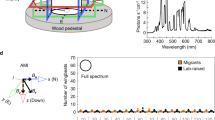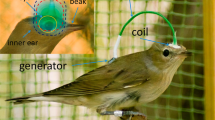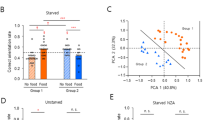Abstract
THE Earth's magnetic field provides an important source of directional information for terrestrial organisms1,5, but the sensory receptor or receptors responsible for magnetic field detection have yet to be identified. Theoretical models of the mechanism of magnetoreception have implicated specialized photoreceptors6,7. The proposed mechanisms would amplify the weak interaction of the geomagnetic field with a single electron spin to the level of photon detection, resulting in a modulation of the photoreceptor response to light. Although behavioural8,9 and neurophysiological10–12 studies have established a link between magnetic field sensitivity and the visual system, definitive evidence for the use of a light-dependent magnetoreception mechanism has been lacking. Here we show that magnetic compass orientation in a semiaquatic salamander is affected by the wavelength of light13, and that this wavelength-dependence is due to a direct effect of light on the underlying magnetoreception mechanism.
This is a preview of subscription content, access via your institution
Access options
Subscribe to this journal
Receive 51 print issues and online access
$199.00 per year
only $3.90 per issue
Buy this article
- Purchase on Springer Link
- Instant access to full article PDF
Prices may be subject to local taxes which are calculated during checkout
Similar content being viewed by others
References
Wiltschko, W. & Wiltschko, R. Experientia 46, 342–352 (1990).
Burda, H., Mayrhold, S., Westenberger, T., Wiltschko, R. & Wiltschko, W. Experientia 46, 528–530 (1990).
Sinsch, U. J. comp. Physiol. 161, 715–727 (1987).
Quinn, T. P. & Brannon, E. L. J. comp. Physiol. 147, 547–552 (1982).
Phillips, J. B. Science 233, 765–767 (1986).
Leask, M. J. M. Nature 267, 144–145 (1977).
Schulten, K. Adv. Solid State Phys. 22, 61–83 (1982).
Wiltschko, W. & Wiltschko, R. Nature 291, 433–434 (1981).
Olcese, J., Reuss, S. & Semm, P. Life Sci. 42, 605–613 (1988).
Semm, P., Nohr, D., Demaine, C. & Wiltschko, W. J. comp. Physiol. 155, 283–288 (1984).
Semm, P. & Demaine, C. J. comp. Physiol. 159, 619–625 (1986).
Phillips, J. B. & Borland, S. C. Ethol. Ecol. Evol. 4, 33–42 (1992).
Phillips, J. B. J. comp. Physiol. 158, 103–109 (1985).
Phillips, J. B. & Borland, S. C. Anim. Behav. (in the press).
Wiltschko, W. & Wiltschko, R. Science 176, 62–64 (1972).
Beason, R. C. Ethology 81, 291–299 (1989).
Reuter, R. & Virtanen, K. J. comp. Physiol. 109, 337–343 (1976).
Backstrom, A. C. & Reuter, T. J. Physiol. Lond. 246, 79–107 (1975).
Tempel, P., Himstedt, W. & Steinke, S. Zool. Jb. Zool. 86, 401–412 (1982).
Dodt, E. & Heerd, E. J. Neurophysiol. 25, 405–429 (1963).
Demaine, C. & Semm, P. Neurosci. Lett. 62, 119–121 (1985).
Kirschfeld, K., Hardie, R., Lentz, G. & Vogt, K. J. comp. Physiol. 162, 421–433.
Batschelet, E. Circular Statistics in Biology (Academic, New York, 1981).
Author information
Authors and Affiliations
Rights and permissions
About this article
Cite this article
Phillips, J., Borland, S. Behavioural evidence for use of a light-dependent magnetoreception mechanism by a vertebrate. Nature 359, 142–144 (1992). https://doi.org/10.1038/359142a0
Received:
Accepted:
Issue Date:
DOI: https://doi.org/10.1038/359142a0
This article is cited by
-
Effects of low-level RF fields reveal complex pattern of magnetic input to the avian magnetic compass
Scientific Reports (2023)
-
Human magnetic sense is mediated by a light and magnetic field resonance-dependent mechanism
Scientific Reports (2022)
-
Why is it so difficult to study magnetic compass orientation in murine rodents?
Journal of Comparative Physiology A (2022)
-
The amphibian magnetic sense(s)
Journal of Comparative Physiology A (2022)
-
Magnetoreception and magnetic navigation in fishes: a half century of discovery
Journal of Comparative Physiology A (2022)
Comments
By submitting a comment you agree to abide by our Terms and Community Guidelines. If you find something abusive or that does not comply with our terms or guidelines please flag it as inappropriate.



